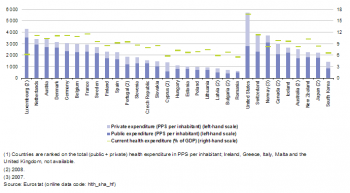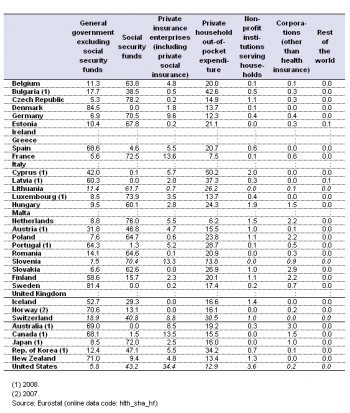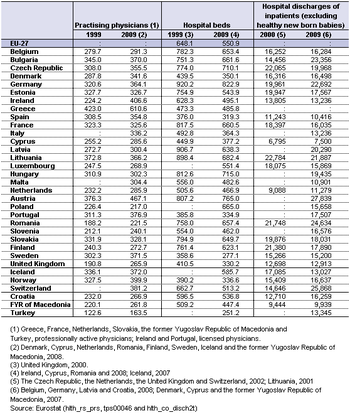Archive:Healthcare statistics
- Data from September 2011, most recent data: Further Eurostat information, Main tables and Database.
This article presents key statistics on monetary and non-monetary aspects of healthcare in the European Union (EU) and its Member States. The state of health of individuals and of the population in general is influenced by genetic and environmental factors, cultural and socio-economical conditions, as well as the healthcare services that are available. Healthcare systems are organised and financed in different ways across the EU Member States, but most Europeans would agree that universal access to good healthcare, at an affordable cost to both individuals and society at large, is a basic need.


(% of current health expenditure) - Source: Eurostat (hlth_sha_hf)

(% of current health expenditure) - Source: Eurostat (hlth_sha_hf)

(% of current health expenditure) - Source: Eurostat (hlth_sha_hf)

(per 100 000 inhabitants) - Source: Eurostat (hlth_rs_prs), (tps00046) and { (hlth_co_disch2t)

(per 100 000 inhabitants) - Source: Eurostat (hlth_co_disch2)

(days) - Source: Eurostat (hlth_co_inpst)
Monetary and non-monetary statistics may be used to evaluate how a country's healthcare system responds to this basic need, through measuring financial, human and technical resources within the healthcare sector and the allocation of these resources between healthcare activities (for example, preventive and curative care), groups of healthcare providers (for example, hospitals and ambulatory centres), or healthcare professionals (for example, medical and paramedical staff). Combining these data with information on technical and managerial choices that are made in relation to healthcare provision (for example, the use of inpatient or outpatient care, or the average length of stays in hospital), it is possible to assess and measure the performance of healthcare systems.
Main statistical findings
Healthcare expenditure
Total current healthcare expenditure (both in relative and absolute terms) varied significantly among the EU Member States in 2009 [1]. As shown in Figure 1 the share of current healthcare expenditure exceeded 11 % of gross domestic product (GDP) in four EU Member States i.e. France, Niederland, Germany and Denmark, which represented almost twice the share recorded in Romania and Cyprus (below 6 % of GDP). The disparity was even bigger when comparing the level of healthcare spending per inhabitant, which varied from PPS 608 in Romania to more than PPS 4 280 in Luxembourg. Notwithstanding the differences in organising and financing healthcare systems, these comparisons suggest that individuals living in those Member States with a higher average level of income per capita generally spend more on purchasing healthcare goods and services.
Public and private healthcare expenditure by financing agent
The mix of public and private funding reflects specific arrangements in healthcare financing systems across the EU Member States. Table 1 provides a breakdown of healthcare expenditure into public and private units that incur health expenditure. Public funding dominates the healthcare sector in the majority of EU Member States, the main exception being Cyprus (2008), where public funding accounted for a 42 % share of total funding. Among Member States for which data are available in 2009, the share of public funding in current healthcare spending ranged from 69 % in Slovakia to more than 80 % in the Netherlands, Denmark, the Czech Republic and Sweden.
Public financing of healthcare is conducted through a variety of funding paths. For example, social security accounted for three quarters or more of overall spending on healthcare in the Czech Republic (78%) and the Netherlands (76 %) in 2009. In contrast, Denmark and Sweden reported that government financing accounted for more than four fifths of their total current expenditure on healthcare.
Private expenditure on healthcare is often used as an indicator to measure the accessibility of healthcare systems. The major source of private funding in 2009 was direct household payments, referred to as 'out-of-pocket' expenditure, which in the Netherlands and France represented respectively 6.2% and 7.5% of current healthcare expenditure, a share that rose to over 40 % of overall spending on healthcare in Bulgaria (2008), and to half of all healthcare expenditure in Cyprus (2008). Private insurance generally represented a small share of healthcare financing among the Member States for which data are available; its relative share only exceeded 10 % in Slovenia and France.
Healthcare expenditure by function
The functional patterns of healthcare expenditure presented in Table 2 show that in 2009 curative and rehabilitative services incurred more that 50 % of current healthcare expenditure in the majority of EU Member States, the exceptions being Slovakia, Romania and Hungary.
Medical goods delivered to outpatients was the second largest function, with average spending accounting for around one quarter of total current healthcare expenditure – although with a significant degree of variation, from 11 % in Denmark Denmark up to more than one third of the total in Bulgaria (2008), Slovakia and Hungary.
Services related to long-term nursing care accounted for less than 10 % of current healthcare expenditure in more than half of the Member States, but reached almost 20 % in Luxembourg and just over 21 % in Denmark. It should be noted that the relatively low share reported for many Member States could well be due to the main burden of long-term nursing care residing with family members with no payment being made for providing these services. In addition, limitations within the data compilation exercise also make it difficult to separate medical and social components of expenditure on long-term nursing care, leading to an inevitable impact on cross-country comparisons.
The proportion of current healthcare expenditure incurred by ancillary services such as laboratory testing or the transportation of patients varies significantly among EU Member States, ranging from 2.4 % in Belgium to 10 % in Estonia. Similarly, expenditure related to prevention and public health programmes exhibits large discrepancies between Member States. In both cases the figures are likely to provide an under-estimate of the true values, as it is likely that some of the expenditure is attributed to medical treatment and as such may be recorded under the heading of curative care. Expenditure on healthcare administration and health insurance was generally lower in those Member States with centralised social security systems or those Member States where private insurance plays a relatively restricted role, ranging from less than 1.5 % of total current healthcare expenditure in Bulgaria, Portugal, Denmark, Hungary and Sweden, through to 7 % and more of expenditure in France and Belgium. In general, the expenditure associated with collective services reported under preventive programmes and the administration of healthcare systems did not surpass 10 % of overall current healthcare expenditure except in the Netherlands and Belgium.
Healthcare expenditure by provider
The breakdown of current healthcare expenditure by provider is shown in Table 3. Hospitals generally accounted for the highest share of expenditure, ranging from 27 % in Slovakia to more than 46 % in Denmark, Estonia, and Sweden. The second most important category was that of ambulatory care providers, its share ranging from just over 16 % of total healthcare expenditure in Romania and Bulgaria to more than 30 % of the total in Germany, Finland, Cyprus and Portugal. The share of various retail establishments and other providers of medical goods varied considerably more – around threefold – from 11 % in Luxembourg and 13 % in Denmark, through a middle band of Member States where the share was between 16 % and 27 %, to 30 % or more of total healthcare provision in Lithuania, Hungary, Bulgaria and Slovakia. However, it should be borne in mind that healthcare providers classified under the same group do not necessarily perform the same set of activities. Hospitals, for example, may, in addition to inpatient services, offer outpatient, ancillary or other type of services.
Non-expenditure data on healthcare
High demand for healthcare staff in some Member States may result in qualified resources moving from other countries. One of the key indicators for measuring healthcare staff is the total number of physicians (head count), expressed per 100 000 inhabitants. In this context, Eurostat gives preference to the concept of practising physicians (although data are not available for six Member States - being replaced by the number of professionally active physicians for Greece, France, the Netherlands and Slovakia, and by the number of licensed physicians for Ireland and Portugal) – see Table 4.
In 2009 the highest number of practising physicians per 100 000 inhabitants was recorded in Austria (467.1) followed by Sweden (371.5) among the EU Member States, while Norway (399.9), Switzerland (381.2) and Iceland (372.0) recorded a ratio between these two figures. Between 1999 and 2009 the number of physicians per 100 000 inhabitants increased in the majority of EU Member States, although reductions were recorded in Estonia, Lithuania, Hungary and Poland. Nevertheless, the reduction of practising physicians in Poland may be explained by several breaks in the data series - for example, from 2004 the Polish data excludes private practices (thought to account for about 2 000 physicians).
The number of hospital beds per 100 000 inhabitants in 2009 ranged among those Member States for which data are available from 277 in Sweden to 823 in Germany, with Turkey (251) below the Swedish level. During the ten years between 1999 and 2009, the number of hospital beds per 100 000 inhabitants fell in every Member State, except Greece. The largest reductions in the availability of hospital beds were recorded in the three Baltic Member States and in Italy. The reduction in hospital bed numbers may reflect, among others, economic constraints, increased efficiency through the use of technical resources (for example, imaging equipment), a general shift from inpatient to outpatient operations, and shorter periods spent in hospital following an operation.
A closer look at the availability of hospital beds, broken down for curative care beds and psychiatric beds (see Table 5) shows a reduction in bed numbers between 1999 and 2009 in each of the Member States for which data are available, except for the number of curative care beds in Greece and for the number of psychiatric beds in Bulgaria, Germany and Austria. The EU-27 averaged 308 curative care beds and 44 psychiatric care beds per 100 000 inhabitants in 2009.
In terms of healthcare activity, diseases of the circulatory system often accounted for the highest number of hospital discharges in 2009 – see Table 6. One third of the Member States for which data are available reported in excess of 3 000 discharges per 100 000 inhabitants for diseases of the circulatory system. The average length of a hospital stay was generally highest among those patients suffering from cancer or problems relating to the circulatory system (see Table 7).
Data sources and availability
Eurostat, the Organisation for Economic Co-operation and Development (OECD) and the World Health Organization (WHO) have established a common framework for a joint healthcare data collection. Following this framework, EU Member States submit their data to Eurostat on the basis of a gentlemen's agreement. The data collected relates to:
- healthcare expenditure following the methodology of the system of health accounts (SHA);
- statistics on human and physical resources in healthcare – supplemented by additional Eurostat data on hospital activities (discharges and procedures).
Healthcare expenditure
Healthcare data on expenditure are based on various surveys and administrative (register-based) data sources, as well as estimations made within the Member States, reflecting country-specific ways of organising healthcare and different reporting system for the collection of statistics pertaining to healthcare.
Total current healthcare expenditure quantifies the economic resources of both the public and private sectors dedicated to healthcare, with the exception of those related to capital investment. It reflects current expenditure of resident units on final consumption of goods and services directed at improving the health status of individuals and of the population.
The SHA provides a framework for interrelated classifications and tables relating to the international reporting of healthcare expenditure and its financing. The set of core SHA tables addresses three basic questions: i) who finances healthcare goods and services; ii) which healthcare providers deliver them, and; iii) what kinds of healthcare goods and services are consumed. Consequently, the SHA is organised around a tri-dimensional system for the recording of health expenditure, by means of the international classification for health accounts (ICHA), defining:
- healthcare expenditure by financing agents (ICHA-HF) – which provides a breakdown of public and private units that directly pay providers for their provision of healthcare goods and services;
- healthcare expenditure by provider (ICHA-HP) – which classifies units contributing to the provision of healthcare goods and services such as hospitals, various outpatients settings, diagnosis centres or retailers of medical goods;
- healthcare expenditure by function (ICHA-HC) – which details the split in healthcare expenditure following the purpose of healthcare activities - such as, health promotion, curing illnesses, rehabilitation or long-term care.
Data coverage is close to 100 % for the first-digit level of each of the three core classifications, but ranges between 75 % and 85 % at the second-digit level. However, it is possible that despite relatively high rates of coverage, there may be departures from the standard classifications. Expenditure reported under some of these ICHA categories may be under or overestimated and it is recommended to refer to specific country metadata before analysing the data.
Non-expenditure data on healthcare
Non-expenditure healthcare data are mainly based on administrative national sources. However, a few countries compile this information from surveys. As a consequence, the information collected is not always comparable. Information on the non-expenditure component of healthcare can be divided into two broad groups of data:
- resource-related healthcare data on human, physical and technical resources, including staff (such as physicians, dentists, nursing and caring professionals, pharmacists and physiotherapists) and hospital beds;
- output-related data that focuses on hospital patients and their treatment(s), in particular for inpatients.
Hospitals are defined according to the classification of healthcare providers within the SHA; all public and private hospitals should be covered.
Data on healthcare staff, in the form of human resources available for providing healthcare services, are provided irrespective of the sector of employment (in other words, regardless of whether the personnel are independent, employed by a hospital, or any other healthcare provider). Three main concepts are used for health professionals: practising, professionally active and licensed. Practising physicians provide services directly to patients; professionally active physicians include those who practice as well as those working in administration and research with their medical education being a pre-requisite for the job they carry out; physicians licensed to practice are those entitled to work as physicians plus, for example, those who are retired.
Hospital bed numbers provide information on healthcare capacities, in other words on the maximum number of patients who can be treated by hospitals. Hospital beds (occupied or unoccupied) are those which are regularly maintained and staffed and immediately available for the care of admitted patients. This indicator should ideally cover beds in all hospitals, including general hospitals, mental health and substance abuse hospitals, and other specialty hospitals. The statistics should include public as well as private sector establishments – although some Member States provide data only for the public sector – for example, Denmark (psychiatric beds), Ireland (total and curative beds), Cyprus (curative and psychiatric beds) and the United Kingdom. Curative care (or acute care) beds are those that are available for curative care; these form a subgroup of total hospital beds.
Output-related indicators focus on hospital patients and cover the interaction between patients and healthcare systems, namely in the form of the treatment they receive. Data are available for a range of indicators including hospital discharges of inpatients and day cases by age, gender, and selected (groups of) diseases; the average length of stay of inpatients; or the medical procedures performed in hospitals. The number of hospital discharges is the most commonly used measure of the utilisation of hospital services. Discharges, rather than admissions, are used because hospital abstracts for inpatient care are based on information gathered at the time of discharge.
Context
Health outcomes across the EU are strikingly different according to where you live, your ethnicity, gender and socio-economic status. The EU promotes the coordination of national healthcare policies through an open method of coordination which places particular emphasis on the access to, and the quality and sustainability of healthcare. Some of the main objectives include: shorter waiting times; universal insurance coverage; affordable care; more patient-centred care and a higher use of outpatients; greater use of evidence-based medicine, effective prevention programmes, generic medicines, and simplified administrative procedures; and strengthening health promotion and disease prevention.
In the current economic climate, access to healthcare, the introduction of technological progress and greater patient choice is increasingly being considered against a background of financial sustainability. Many of the challenges facing governments across the EU are outlined in the European Commission’s White paper, titled ‘Together for health: a strategic approach for the EU 2008-2013’ (COM(2007) 360).
Further Eurostat information
Publications
- Health in Europe – Data 1998-2003, Eurostat pocketbook 2006
- Health statistics – Key data on health 2002 – Data 1970 – 2001
Main tables
- Health, see:
- Public health
- Main tables
- Public health (t_hlth)
- Health care: resources and patients (non-expenditure data) (t_hlth_care)
- Health care: indicators from surveys (SILC, HIS round 2004) (t_hlth_care1)
- Health status: indicators from surveys (SILC, HIS, LFS) (t_hlth_state)
- Public health (t_hlth)
- Main tables
Database
- Health, see:
- Public health
- Database
- Health care expenditure (hlth_sha)
- Health care: resources and patients (non-expenditure data) (hlth_care)
- Health care: indicators from surveys (SILC, HIS round 2004) (hlth_care1)
- Health status: indicators from surveys (SILC, HIS, LFS) (hlth_state)
- European health interview survey (EHIS) (hlth_ehis)
- Database
Dedicated section
Methodology / Metadata
- Health care expenditure (ESMS metadata file - hlth_sha_esms)
- Health care: resources and patients (non-expenditure data) (ESMS metadata file - hlth_care_esms)
Source data for tables and figures (MS Excel)
External links
See also
Notes
- ↑ Belgium, Denmark, France, the Netherlands, Austria and Finland, 2007; Latvia, Portugal and Slovakia, 2006.

